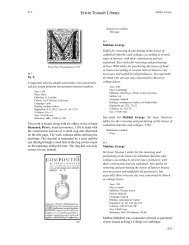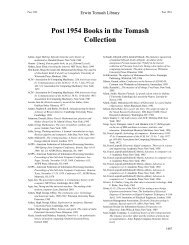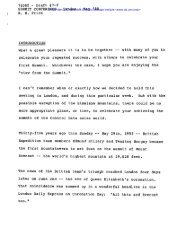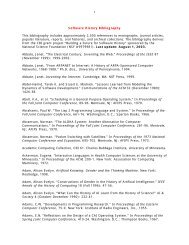B chapter.indd - Charles Babbage Institute - University of Minnesota
B chapter.indd - Charles Babbage Institute - University of Minnesota
B chapter.indd - Charles Babbage Institute - University of Minnesota
You also want an ePaper? Increase the reach of your titles
YUMPU automatically turns print PDFs into web optimized ePapers that Google loves.
236<br />
Erwin Tomash Library<br />
Byrne, Oliver Byrne, Oliver<br />
the mere description <strong>of</strong> circles, and the use <strong>of</strong> coloured<br />
diagrams and symbols..<br />
Year: 1877<br />
Place: London<br />
Publisher: Crosby, Lockwood, and Co.<br />
Edition: 1st<br />
Language: English<br />
Figures: frontispiece figure in red and black, 36 full-page<br />
figures (19 in color)<br />
Binding: original cloth boards<br />
Pagination: pp. iv, [74]<br />
Collation: A–D 8 E 7<br />
Size: 186x123 mm<br />
In this work Byrne demonstrates the solution <strong>of</strong> several<br />
geometric problems by the use <strong>of</strong> the compass. Of major<br />
interest is the use <strong>of</strong> color to illustrate the different<br />
compass radii and movements. This may be regarded<br />
as an extension <strong>of</strong> Byrne’s most successful book, The<br />
first six books <strong>of</strong> the elements <strong>of</strong> Euclid, in which colored<br />
diagrams and symbols are used instead <strong>of</strong> letters for<br />
the greater ease <strong>of</strong> learners. London, 1847 (not in the<br />
collection).<br />
Illustrations available:<br />
Title page<br />
Frontispiece<br />
B 312<br />
B 313<br />
Byrne, Oliver (1810–1880)<br />
Mechanics: Their principles and practical applications<br />
Year: 1853<br />
Place: New York<br />
Publisher: De Witt & Davenport<br />
Edition: 1st<br />
Language: English<br />
Binding: original gilt-pictorial cloth boards; gilt spine faded<br />
Pagination: pp. 182<br />
Collation: 1 4 1* 8 -7 4 7* 8 8 4 8* 3<br />
Size: 185x122 mm<br />
In this work Byrne describes himself as a civil, military,<br />
and mechanical engineer. He points out that there are<br />
already a great many books describing mechanical<br />
devices; his has the advantage that it stands in the same<br />
relation to the execution <strong>of</strong> works, and the construction<br />
<strong>of</strong> machines, as Descriptive Geometry stands to the<br />
drawing <strong>of</strong> machines. Once the reader has attempted<br />
to digest that boast, he or she is treated to a complex<br />
jumble <strong>of</strong> physical principles in the rest <strong>of</strong> the volume.<br />
While Byrne certainly does describe simple mechanical<br />
devices such as the lever, pulley and gears, the examples<br />
given are seldom the practical applications <strong>of</strong> the title.<br />
They <strong>of</strong>ten refer to hypothetical falling balls, balancing<br />
<strong>of</strong> eggs, etc. When Byrne does consider more practical<br />
problems, he assumes idealized conditions. For example,<br />
he notes that the inclined plane must be considered to be<br />
a perfectly hard, smooth, inflexible surface … and other<br />
such less than realistic considerations.<br />
Illustrations available:<br />
Title page<br />
Book binding, front gilt<br />
Frontispiece, B 312







